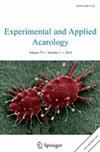从鸟巢对柱头线虫群落的取食设计进行横切和对比。
摘要
本文首次采用标准化剖面法对17种常见于鸟巢的散居散头螨的螯合可动趾形态进行了分解。沿着咀嚼表面的对比被用来探测营养特征,从而解释该群落中不同物种的共存。除食Thyreophagus, entomophagus TH3和Lepidoglyphus destructor G6之间的可动趾设计过渡外,一般剖宫图的变化跟踪了螯虫科和螯虫科的几何相似性变化。发现全切口(Aleuroglyphus ovatus AL2和Chortoglyphus arcuatus CH1)和特别薄切口(Acarus farris A17)种。可移动的“指尖角”和前区(指尖所在的位置,称为“远端指角”)的角度钝度都反映了手指的健壮性。可活动手指的腹表面固有曲率似乎在所有物种中都很常见。与其他类群相比,粗毛Acarus A4、glycyhagus domesticus G5和鳞翅目destructor G6的趾尖比预期的要强。这种加强螯合力的速率因物种而异。在整个可移动手指的分布中,我们发现了从食糖虫到螨类再到腐糖虫的设计转变,以及害虫物种之间的进化路径(Rhizoglyphus robini R1,通过Tyrophagus longior T40,再到Tyrophagus purescentiae T13)。细轮A4看起来很独特。其中,棕榈巨噬鼠T17和T32、相似巨噬鼠T21和T44相互之间的重复难以区分,属于基础形态。长巨噬鼠T40、腐腐巨噬鼠T13、固定巨噬鼠A1、酪巨噬鼠T62和法ris巨噬鼠A17与本研究中观察到的基础总体剖面形态取样变化尺度仅存在轻微差异。其中弓形蝗CH1、食食蝗TH3、robini根茎蝗R1、大糖蝗G3和翼状棘蝗D3的基支比细尾蝗A4、粗尾蝗S5、家食蝗G5、破坏鳞蝗G6和卵形蝗AL2的基支更高,有时更圆。大部分的燕窝无柱头的种类有一个共同的轮廓模式,明显的凹凸在他们的咀嚼表面。虽然有两个物种,Rhizoglyphus robini R1和Chortoglyphus arcuatus CH1,在这个共同的“Bauplan”上有一些夸张的特征(可能是为了更大的内收力而缩放)。某些物种:固定Acarus immobilis A1、Dermatophagoides pteronyssinus D3、Glycometrus hugheseae G3、Glycyphagus domesticus G5、Lepidoglyphus destructor G6和Tyrophagus purescentiae T13,具有个体特征明显的咀嚼面。这些物种必须以不同的方式或以不同的材料筑巢。讨论了基支和螯合杠杆的差异。在未来的工作中,需要对上升分支和特定齿列进行更多的研究,以解释该生境中某些剩余的螨虫共存。The chelal moveable digit patterns of seventeen free-living astigmatan mites commonly found in bird nests is decomposed (for the first time) into functional groups using standardised profiles. Contrasts along the mastication surface are used to detect trophic features so as to explain the coexistence of different species in that community. Variation in profiles in general track geometric similarity changes in chelicerae and chelae, except in the moveable digit design transition between Thyreophagus entomophagus TH3 and Lepidoglyphus destructor G6. Full-kerf (Aleuroglyphus ovatus AL2 and Chortoglyphus arcuatus CH1) and particularly thin-kerf (Acarus farris A17) species are found. Both the moveable 'digit tip angle' and the angular bluntness of the anterior region (on which the tip sits, denoted the 'distal digit angle'), mirror digit robustification.Ventral surface intrinsic curvature of the moveable digit appears common across species. Acarus gracilis A4, Glycyphagus domesticus G5 and Lepidoglyphus destructor G6 have more than expected strengthened digit tips compared to other taxa. Rates of this strengthening with chelal occlusive force varies across species. With respect to the whole moveable digit profile a design transition from glycyphagids through acarids to pyroglyphids is found, along with an evolutionary path amongst pest species (Rhizoglyphus robini R1, through Tyrophagus longior T40, to Tyrophagus putrescentiae T13). Acarus gracilis A4 appears unique. In particular Tyrophagus palmarum T17 & T32 and Tyrophagus similis T21 & T44 are indistinguishable from replicates of each other and typify a basal form Tyrophagus longior T40, Tyrophagus putrescentiae T13, Acarus immobilis A1, Tyrolichus casei T62 and Acarus farris A17 are only mildly different from the observed scale of sampling variation of the basal overall profile form in this study Two design groups of ever increasing post-horizontal ramus investment are clear, with the basal rami of Chortoglyphus arcuatus CH1, Thyreophagus entomophagus TH3, Rhizoglyphus robini R1, Glycometrus hugheseae G3 and Dermatophagoides pteronyssinus D3 being taller and sometimes more rounded than those of the distinct group Acarus gracilis A4, Suidasia pontifica S5, Glycyphagus domesticus G5, Lepidoglyphus destructor G6 and Aleuroglyphus ovatus AL2. The bulk of the bird nest astigmatan species have a common profile pattern of apparent asperities on their mastication surface. Although, two species, Rhizoglyphus robini R1 and Chortoglyphus arcuatus CH1, have somewhat exaggerated features on this common 'Bauplan' (perhaps scaled for greater adductive force). Certain species: Acarus immobilis A1, Dermatophagoides pteronyssinus D3, Glycometrus hugheseae G3, Glycyphagus domesticus G5, Lepidoglyphus destructor G6 and Tyrophagus putrescentiae T13, have an individualised distinctly featured mastication surface. These species must each feed differently or on different material in bird nests. Basal ramus and chelal leverage differences are discussed. More work on the ascending ramus and specific dentition in future work is needed to explain certain remaining mite coexistences in this habitat.

 求助内容:
求助内容: 应助结果提醒方式:
应助结果提醒方式:


